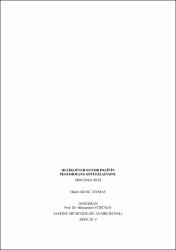Helikopter rotor palinin performans optimizasyonu
Özet
Modern helikopterler, görevleri ve çalışma ortamları nedeniyle kullanım ömrü boyunca yüksek seviyelerde titreşim ve yorulmalara maruz kalan karmaşık dinamik sistemlerdir. Titreşim, helikopter rotoru tasarımı ve performans çalışmalarında dikkate alınması gereken en önemli faktörlerden birisidir. Titreşimin mekanik sistem bileşenlerine verdiği zararın yanı sıra mürettebat ve yolcuların sağlık durumlarını olumsuz etkilemesi, okuma güçlüğü, silah sistemlerinin etkisizliği ve yüksek bakım maliyetleri gibi istenmeyen sonuçları da bulunmaktadır.
Bu araştırmada, helikopter rotor başındaki titreşiminin azaltılarak helikopter performansının arttırılması hedeflenmiştir. Helikopter rotor tasarımında, titreşimi en aza indirmek için yaygın olarak aktif ve pasif kontrol yöntemleri kullanılmaktadır. Aktif kontrol yöntemlerinde; sensörler, tahrik sistemleri ve denetleyiciler aracılığıyla sistemden anlık geri bildirimler gelmekte ve önemli ölçüde karmaşıklık içermektedir. Buna karşın pasif kontrol yöntemlerinde yüke ve geldiği yöne uygun anlık tepki veren titreşim sönümleyici, izolatörler ve malzemelerin yapısal dağılımı gibi daha az karmaşık bileşenler kullanılmaktadır. Ayrıca pasif kontrol yöntemleri içerisinde yer alan malzemenin yapısal optimizasyonunu, "indirgenmiş titreşim formülü" ile incelemek mümkün olmaktadır. Bu eşitlik; rotor başında meydana gelen titreşimi, rotor başı kayma kuvvetleri ve momentleri cinsinden ifade etmektedir.
Bu tezde indirgenmiş titreşim formülü, performans optimizasyonu modelinin amaç fonksiyonu olarak kullanılmıştır. Kısıtlar; kesit geometrisi sınırlandırmaları ve doğal frekans, otorotasyon ve Tsai-Hill hasar kriteri gibi malzemenin yapısal özellikleridir. Kompozit tabaka açıları ve spar geometrisi tasarım değişkenleridir. Optimizasyon yöntemi olarak hibrit bir algoritma tercih edilmiştir. Gradyan tabanlı algoritmaların güvenli bölgede kesin sonuçlar üretmesi ve sezgisel yöntemlerin arama uzayını geniş tarayabilmeleri sebebiyle parçacık sürüsü algoritması ve gradyan tabanlı algoritmalar hibrit edilmiştir.
İleri uçuş durumunda olan helikopter için yapılacak olan performans iyileştirmesinde kesit analizi için VABS yazılımı kullanılmıştır. Kesit geometrilerine ait mesh (ağ düğüm) bilgileri, PYTHON script yardımıyla ABAQUS ile üretilmiştir. Hava araçlarının dinamik analizlerinde kullanılmakta olan DYMORE programı ile rotor başına uygulanan kuvvet ve momentler hesaplanmıştır. Her iterasyondaki VABS, ABAQUS ve DYMORE arasındaki sıralı işlemlerin gerçekleşmesi için Microsoft’un yeni nesil programlama dili olan C#’tan faydalanılmıştır. Optimizasyon, MATLAB sayısal analiz ve hesaplama programı ortamında yapılmıştır.
Optimize edilmiş sonuçlar referans UH-60 helikopter rotor başı titreşimi ile karşılaştırılmış ve yeni tasarımda rotor başında yaklaşık yüzde 38’lik titreşim azalması gözlemlenmiştir. Modern helicopters are complex dynamic systems that are subject to high levels of vibration and fatigue during their lifetime, due to their tasks and working environments. Vibration is one of the most important factors to consider in helicopter rotor design and performance studies. In addition to the damage caused to the mechanical system components of vibration, there are also negative consequences such as human discomfort and disease, difficulty in reading, ineffectiveness of weapon systems and high maintenance costs.
In this study, it is aimed to increase helicopter performance by reducing helicopter rotor blade vibration. In helicopter rotor design, active and passive control methods are widely discussed to minimize vibration. In active control methods; it comes with instant feedback to the system through sensors, propulsion systems and controllers, and the system includes significant complexity. In contrast, passive control methods use less complex components like, vibration absorbers which respond to the load and to the direction of where it comes, isolators, and structural distribution of materials. At the same time, by through passive control methods, it is possible to examine the vibration at the rotor head with "surrogate vibration reduction formula". This equality expresses the vibration at the rotor head in terms of shear forces and moments.
The surrogate vibration formula was used as the objective function of the performance optimization model. Constraints are cross-sectional geometry limitations and structural properties of the material such as frequency placement, autorotation and stress. Composite layer angles and spar geometry are design variables. A hybrid algorithm solution was preferred as an optimization method. Because the gradient-based algorithms produce precise results in the safe zone and the heuristic methods can scan the search space wide, the particle swarm algorithm and the gradient-based algorithm have been hybridized.
The VABS software was used for cross-sectional analysis in the performance improvement to be performed for the helicopter in the flight forward condition.Cross-section geometry's mesh information is produced with ABAQUS using PYTHON script. By the DYMORE program, which is used in the dynamic analysis of air vehicles, calculated the applied forces and moments per rotor. In order to perform sequential transactions between VABS, ABAQUS and DYMORE in each iteration, Microsoft's next-generation programming language, C #, has been utilized. Optimization was done in MATLAB numerical analysis and calculation program.
The optimized results were compared with the reference UH-60 helicopter rotor head vibration and with the new design, observed a vibration reduction of about 38 percent at the rotor hub.
Bağlantı
https://hdl.handle.net/11630/7373Koleksiyonlar
- Doktora Tezleri [57]



















